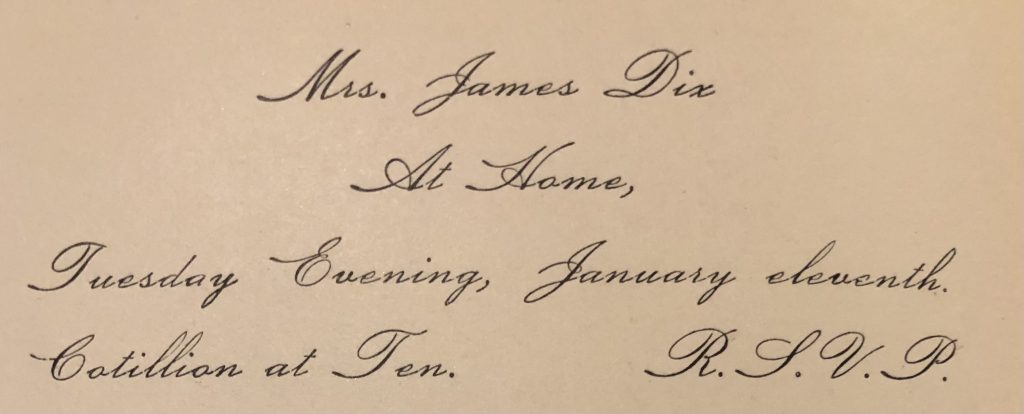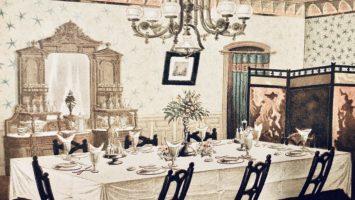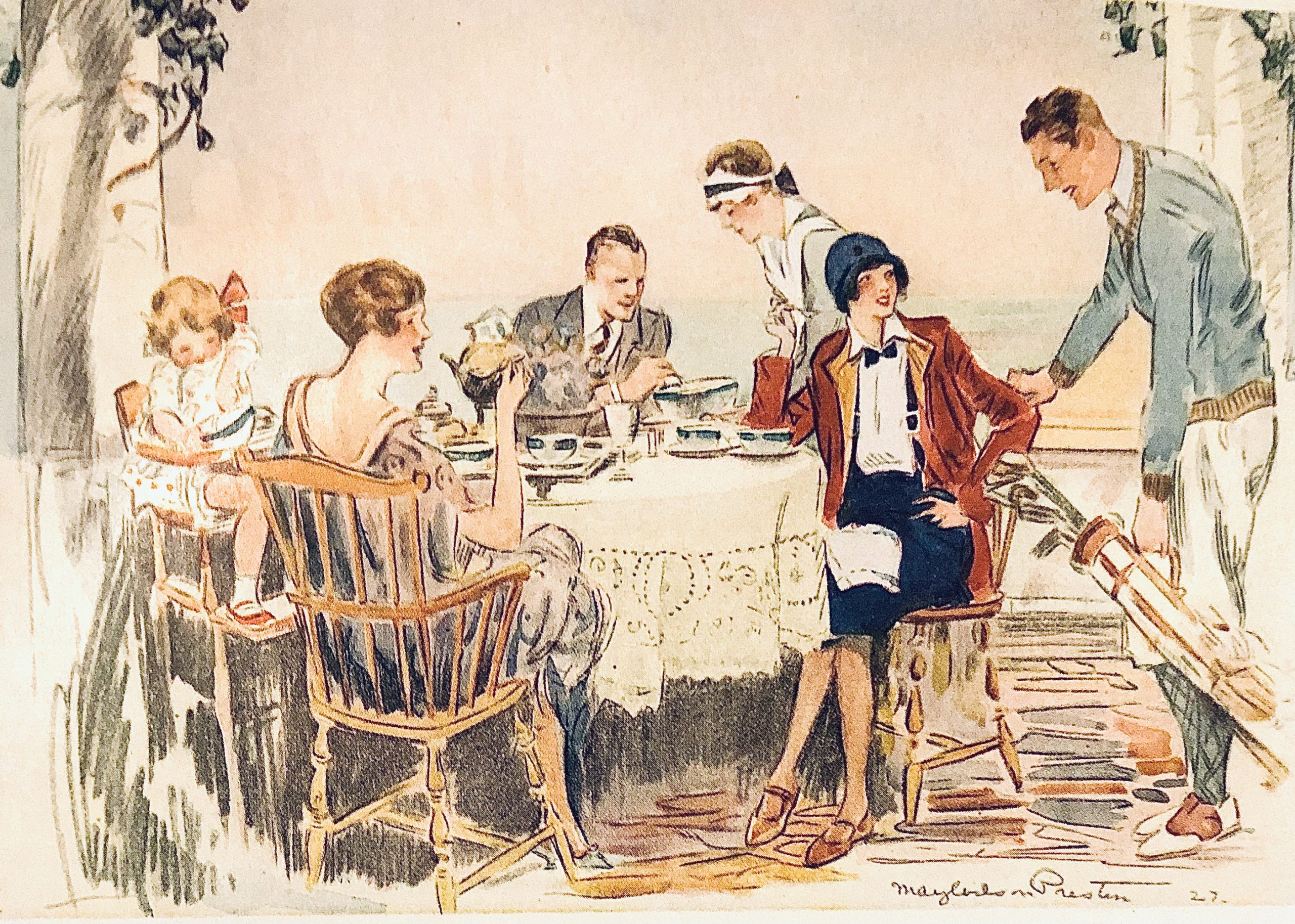Anyone who loves romantic period dramas, loves the idea of a ball. It’s so fanciful, with all those lovely dresses, white tie and top hats. I covered the differences between a Ball and a Dance in an earlier post, but now let’s look at the minutia of going to a ball by planning one.
Where to start?
“Balls, to distinguish them from other evening gatherings with dancing as one of the features of the evening, may be designated as parties given for the express purpose of dancing. Balls should begin at about nine o’clock in the evening, and terminate at two or three in the morning. A private ball may be a very elaborate affair, from fifty to seventy-five guests being necessary to make the occasion enjoyable. Where the size of the ball-room will permit, many more are frequently bidden. Over-crowing should be guarded against, as ruinous to the toilets of the ladies, and the pleasure of all concerned. The invitations to very elaborate affairs are sometimes sent out from three weeks to one month in advance.”
Social Etiquette by Maud C. Cooke, (1899)
“If you cannot afford to give a ball in good style, you had better not attempt it at all. Having made up your mind to give a ball and to do justice to the occasion, and having settled upon the time, the next thing is to decide whom and how many to invite. In deciding upon the number a due regard must be paid to the size of the rooms; and after making allowance for a reasonable number who may not accept the invitation, there should be no more invited than can find comfortable accommodations, both sitting and standing-room being taken into accord, and at the same time have the floor properly free for dancing. The more guests you have the more brilliant, and the fewer you have the more enjoyable, will the occasion be.”
Decorum, (1880)
Now the amount of guests in Social Etiquette is a minimum, not a maximum. Balls could have hundreds of guests and often did in the Regency to Edwardian eras. Also, toilet refers to her clothing and appearance, not the privy.
So, we’ve scraped together the necessary funds, we have a big house with a ballroom and sitting rooms to use, an awning and red carpet and have 70 lovely people in mind. So now we must invite them, but how?

“An invitation to a ball may be issued at any time from three weeks to ten days before the date set for the festivity. The larger and more ambitiously splendid the ball, the longer should be the notice given. Engraved or written invitations may be used with equal propriety. An engraved invitation is inscribed on large white cards; a written invitation is inscribed on double sheets of good note paper.”
Correct Social Usage by The New York Society of Self-Culture, 1907
“Good Society will not tolerate the word “ball” on the invitation cards of the hostess. Something like the following, neatly printed or engraved or written by the hostess herself, would be eminently appropriate. It might be varied somewhat, but the general form should be retained; nothing could be more compact, near and expressive:”


Polite Life and Etiquette by Georgene Corry Benham, (1891)
Setting aside that my idea of “good society” probably differs quite heavily from Georgene’s, we’ve made our invitations and mailed them out. Now our guests RSVP and we await the day.
Oh, wait. We’ve got to plan the darn thing. Let’s pick some music.
“The most important feature of any ball– in fact any kind of a dancing party – is the music. The careful hostess always schedules her ball for a night when the very best in music in not already engaged and , if possible, she gets orchestras that are currently popular. Nothing changes more rapidly than the style of dancing and dance music. Last seasons’ leading “dance band” may be out-of-date today. The number of pieces in the orchestra must be sufficient to have the music reach into every corner of the ballroom over the laughter and conversation of the dancers. At all big balls there are always two orchestras so that there are not intermissions from the start o ft he music to the final note of the night. A popular fad of the present day is to engage two orchestras of quite different types.”
The New American Etiquette by Lily Haxworth Wallace, (1941)
Holy moly. No wonder you needed a lot of money to throw a ball. Now I do not believe that Regency or Victorian balls booked two bands, or at least I haven’t seen any mention of it in any etiquette books I own from those periods. It seems more likely there were longer intervals between songs, especially considering the vivacity with with Regency dances were performed.
We have our orchestra booked and need to ready our environment.
“The ball-room should be large; the floor well waxed, or covered with drugget, and an abundance of palms and potted plants set about to make cosy nook just light by a shade lamp. Cut flowers may be massed upon the mantels with gorgeous effect. If the stairway be of sufficient breadth, it should be bravely furnished forth with plants in bloom. If it should be a first-floor room and open into the cool dusk of a faintly lighted conservatory, then it is everything to be desired for the occasion. Good ventilation is an absolute necessity.”
Social Etiquette by Maud C. Cooke, (1896)
I can’t seem to find what drugget is, but what a lovely sight a ball room must have been. Prior to the Victorian era, ballrooms would have been furnished by candlelight. In the documentary, (which I heartily recommend) Pride and Prejudice Having a Ball, they say that the length of candle indicated how long the party might go for. Once gas and then electricity came in, parties could go and go. Much to the hosts’ chagrin, I’m sure.
By the twenties, the ball was falling out of favor. When they did happen, they had become simpler:
“Flowers are always pleasing. Huge ferns may grace unexpected corners and greens may add a festive note, if the hostess so desires. But there must not be an obvious attempt at decoration. Rather nothing at all, than so very much that it borders on the ostentatious. In fact, the dance is tending more and more to become a simple and unpretentious function. The elaborate decorations and fashionable conventions that attended the minuet and quadrille of several decades ago have given way to a jolly informality which makes the dance so delightful and popular a way of entertaining.”
Book of Etiquette by Lilian Eichler
Now Ms. Eichler was, I’m sure, reporting correctly for her own circle. But it takes only a casual glance at a Dennison party magazine or decorating booklet from the same year, to see that many still preferred extensive and numerous decorations. We are going to hold a Victorian ball, so we’re going to be totally ostntatious! Next, we must think about feeding our guests.
Jane Austen wrote that “A ball without supper is a fraud against young men and women”. Jane was smart. If you’re going to invite a boatload of people over, have them drink alcoholic punch and dance in a lively manner for hours, you’d better feed them or there are going to be some hangry guests.
“A supper is always provided, and the arrangement of the table should be in good taste. Of the conduct at supper, we cannot do better than to quote from a well known authority on matters of etiquette, who says: “It is ill-bread to eat largely at the supper. To say nothing of the ruinous effect of gorging at late hours, it is in bad taste. The ball and evening party, are social affairs, and feasting merely incidental. To reverse the conditions is ill-bred, and even in the temperate and total-abstinents will do well to talk and dance with extra caution after supper, as any license of speech or act may be attributed to the wine which has stolen away brain and self-control at the same time. No well-bred hostess can forgive any such abuse of her hospitality. When supper is announced at a ball, the gentleman invites the ladies with who he happens to be in conversation, or the lady with whom the has danced last, unless he sees that those whom he has escorted, are unattended, in which case his first duty is to them.”
Polite Society at Home and Abroad by Annie R. White, (1891)
Should you have an enormous ballroom that holds hundreds, you may want to go in for a buffet supper. The buffet supper began at one and went for one hour. Sit down suppers could begin as early as midnight, and might go for an hour or two.

We’re going to have a buffet I think. Despite Annie’s admonitions for guests to not gorge themselves, our tables should be plentiful and beautifully decorated.
After this we will assign ushers, make sure there is a cloak room, designate who will call the dances, (different eras have differing methods for this).
Our RSVPs begin coming in. It looks as if we’re going to have a full house. Now we will send out entry cards which will make sure that only our guests attend. Whew! So much has been done, yet there is so much more!
Part two coming up…
I hope you all are well and I promise if I throw a huge ball, I’ll invite you. Much love, Cheri



